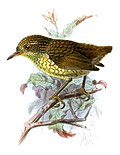Distribution and habitat
The white-cheeked cotinga is primarily found along the western slope of the Andes of Peru from Ancash Department south to Arequipa Department, though it occurs only spottily in the far north and south of its range. There are also a few records on the eastern slope. It almost exclusively inhabits Polylepis forest, whose groves tend to be separated by shrubby grasslands. There are some records in mixed-species woodlands. In elevation it primarily ranges between 3,800 to 4,400 m (12,500 to 14,400 ft) and infrequently occurs as low as 2,700 m (8,900 ft). [5] [6]
Behavior
Movement
The white-cheeked cotinga is essentially a year-round resident though some dispersal to elevations below its core range occurs. [5] [6]
Feeding
The white-cheeked cotinga feeds on fruit, primarily that of mistletoes. Its diet possibly includes insects though there are no observations of such feeding. It mostly forages singly or in pairs, and in the non-breeding season also in small groups. It plucks the fruits while perched, often consuming several in quick succession. It regurgitates the sticky seeds and wipes them from its bill on branches; this practice apparently makes the species the primary dispersal agent of the mistletoes. [5] [6]
Breeding
The white-cheeked cotinga breeds at least in April and May and may begin it season earlier. Two birds appeared to display to each other with bowing, head bobbing, and wing flicking. One well-described nest was a deep cup made from moss and lichens with a few twigs lined with coarse grasses. Most nests have been in large clumps of mistletoe in Polylepis trees between about 4 and 7 m (15 and 25 ft) above the ground. [5]
 | Songs and calls
|
Vocalization
As of August 2025 xeno-canto had four recordings of white-cheeked cotinga vocalizations; the Cornell Lab's Macaulay Library had 11 with much overlap. [7] [8]
The white-cheeked cotinga's song is "a series of deep, burry accelerating quacks into a rising-falling chatter, slowing at the very end" djee-djee-DJEE-DJEE-djee'dje'dje'djer'r'r'r'r'dje'dje". Its call is "a deep, burry series of emphatic quacks: djee-djee-DJEE-DJEE-DJEEP". [6] The species sings mostly early in the morning and late in the afternoon, and usually from an exposed perch. Both members of a pair sing as do other members of the non-breeding season groups. [5]
Status
The IUCN originally in 1988 assessed the white-cheeked cotinga as Threatened, then in 1994 as vulnerable, and since March 2023 as Near Threatened. It is patchily distributed across its range; its estimated population of between 2500 and 10,000 mature individuals is believed to be decreasing. "The most severe threat to the species are uncontrolled cutting of Polylepis woodlands for timber, firewood and charcoal, and heavy grazing by livestock, which prevent forest regeneration". [1] The species is considered rare and local. [6] It occurs in several protected areas though some are only nominally maintained. [5]
This page is based on this
Wikipedia article Text is available under the
CC BY-SA 4.0 license; additional terms may apply.
Images, videos and audio are available under their respective licenses.




